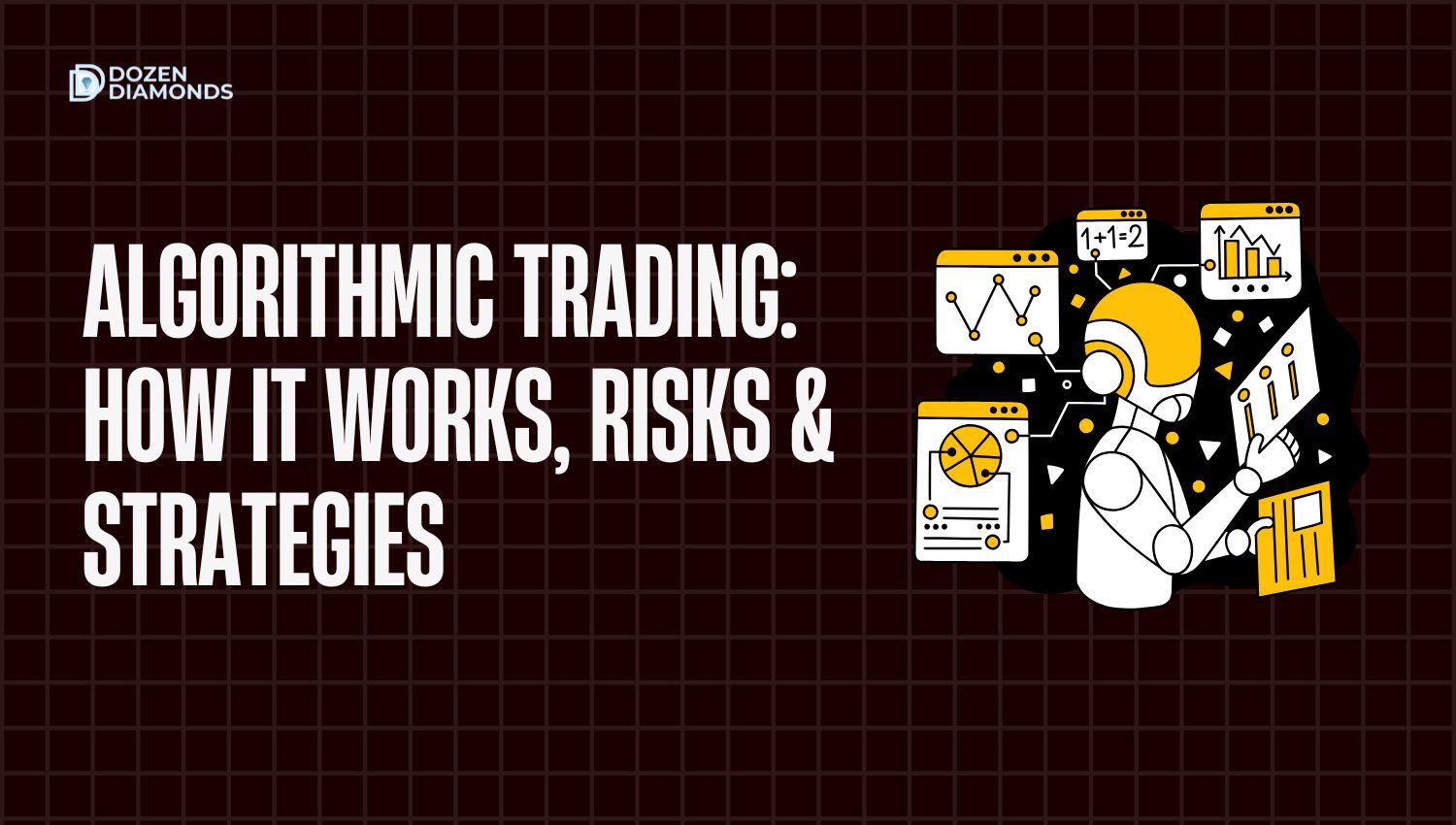Algorithmic Trading: How It Works, Risks & Strategies

Table of Contents
Introduction
After reading this article, you’ll be able to design and backtest a simple algorithmic trading strategy from scratch and understand when it works or fails.
The methods here are grounded in real-world results and academic research — for example, many quant firms report improved risk-adjusted returns using algorithmic trading systems.
You’ll get:
- A clear framework to build a basic algorithmic trading bot
- Awareness of key risks (overfitting, latency, market regime shifts)
- A practical checklist to validate your strategies
What Is Algorithmic Trading?
Algorithmic trading is the use of pre-programmed rules or mathematical models to execute trades automatically, without human intervention, based on criteria like price, time, volume, or other signals. Investopedia
This enables trading at speeds, frequency, and consistency beyond human capability — removing much of the emotional bias. Investopedia
Algorithmic trading is used widely by institutions, and increasingly by retail traders via APIs and frameworks. BajajFinserv
Why It Matters: Advantages & Market Impact
Advantages of algorithmic trading:
- Faster execution and reduced latency — trades enter immediately when conditions are met. Financial Edge
- Reduced emotional / psychological bias — the system follows rules, not fear or greed. Investopedia
- Ability to trade many instruments simultaneously and exploit tiny inefficiencies. Wikipedia
Market impact & role:
Algorithmic trading contributes significantly to market liquidity and efficiency by enabling continuous trading and arbitrage. ScienceDirect
However, it can also amplify volatility (e.g. flash crashes) and introduce systemic risk if many algorithms respond similarly. Investopedia
Key Components & Workflow
| No. | Component | Description |
|---|---|---|
| 1 | Data input / market feed | Real-time price, order book, historical data |
| 2 | Signal generation / strategy logic | Rules or models that determine buy/sell decisions |
| 3 | Risk & position sizing module | Determines how much to trade, stop, etc. |
| 4 | Order execution & routing | Send orders to exchange, possibly via smart order routing Wikipedia |
| 5 | Backtesting & simulation engine | Test strategy on historical data, simulate slippage, latency |
| 6 | Monitoring & safeguards | Alerts, circuit breaks, kill switches, logs |
A robust system must deal with data errors, downtime, network latency, and extreme market conditions. Medium
Popular Strategy Types
Here are some common algorithmic trading strategies:
- Trend following / momentum strategies — enter in the direction of price movement
- Mean reversion strategies — bet on prices returning to a mean
- Statistical arbitrage / pairs trading — trade relative value between correlated assets
- Volume weighted average price (VWAP) / TWAP — slice large orders to minimize market impact FinancialEdge
- High-frequency strategies (HFT) — very short holding periods, often microseconds to seconds. Schwab
- Machine learning / reinforcement learning–based strategies — learn patterns from data pipelines. For example, one paper used deep reinforcement learning to maximize Sharpe ratio over stock markets. arXiv+2arXiv+2
What Many Guides Miss: Robustness, Regime Change & Overfitting
Many articles show ideal backtests or winning strategies — but fail to address:
- Overfitting / curve fitting — designing a model that works only on historical data but fails forward. Medium
- Regime shifts — market dynamics change (bull, bear, volatility regimes) and strategies break.
- Signal decay — once a strategy gets discovered, it may lose edge due to competition.
- Latency, slippage & execution reality — real execution costs kill naive backtests.
- Robust validation methods (walk-forward, out-of-sample tests) — many guides skip these.
Including these in your design and verification helps avoid disasters.
Risks & Common Pitfalls
- Model risk / overfitting — as above, risk your algorithm fits noise.
- Technical failure / downtime — system crash, data feed error, network outage.
- Liquidity risk / slippage — losing money on spreads or market impact.
- Crowded strategies & correlation risk — many algos may behave similarly under stress.
- Regulatory / compliance risk — rules may impose constraints; in India, retail algo trading may need tags, registration. Reuters
Regulatory bodies like FINRA require supervision and controls over algorithmic trading strategies. FINRA
How to Start: Tools, Languages & Steps
- 1. Pick your language / framework — Python is a favorite (libraries like pandas, NumPy, backtrader, Zipline)
- 2. Obtain good data — historical & live (tick or minute level)
- 3. Design simple strategies first — e.g. moving average crossover
- 4. Backtest rigorously — include slippage, commission, out-of-sample data
- 5. Paper trade / simulate live — test without risking capital
- 6. Deploy with proper safeguards — monitoring, kill switches, logs
QuantInsti and other quant blogs have many tutorials for beginners. QuantInsti Blog
Example Strategy Walkthrough
- Buy when 20-period SMA crosses above 50-period SMA
- Sell when 20 SMA crosses below 50 SMA
- Use a stop-loss or trailing exit
Then evaluate:
- How often did it trigger false signals?
- What was average slippage?
- Did adding a filter (e.g. trend confirmation) improve performance?
Checklist: Validate Before You Deploy
- Walk-forward / out-of-sample testing
- Stress test on multiple market regimes
- Ensure latency & execution assumptions are realistic
- Add safety checks / kill switches
- Monitor performance metrics (drawdown, sharpe, max loss)
- Log trades and system health
Final Thoughts
Algorithmic trading offers a powerful way to bring discipline, speed, and scale into your trading approach. But it’s not a “get rich quick” button — success depends on solid design, rigorous testing, and continuous monitoring.
If you build robust systems, manage risk, and adapt to changing markets, you can turn algorithmic trading into a lasting edge rather than a trap.
Next Step: Experience Stressless Algo
Download Kosh App and experience automated wealth creation via stressless algo
FAQs: Algorithmic Trading
- Knowledge of finance & trading
- Understanding of technical indicators
- Coding & data analysis skills
- Risk management expertise